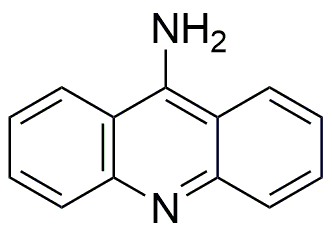9-Aminoacridine is widely utilized in research focused on:
- Antimicrobial Agents: This compound is known for its effectiveness against various bacteria and fungi, making it valuable in developing new antimicrobial treatments.
- Fluorescent Probes: Due to its fluorescent properties, it is used in biological imaging to track cellular processes, aiding researchers in understanding complex biological systems.
- DNA Binding Studies: It interacts with DNA, allowing scientists to study DNA structure and function, which is crucial in genetic research and drug development.
- Cancer Research: 9-Aminoacridine has shown potential in anticancer applications, helping researchers explore new therapeutic avenues for cancer treatment.
- Histological Staining: It is used in staining techniques to visualize cellular components in tissue samples, enhancing the study of histopathology.
Informations générales
Propriétés
Sécurité et réglementation
Applications
9-Aminoacridine is widely utilized in research focused on:
- Antimicrobial Agents: This compound is known for its effectiveness against various bacteria and fungi, making it valuable in developing new antimicrobial treatments.
- Fluorescent Probes: Due to its fluorescent properties, it is used in biological imaging to track cellular processes, aiding researchers in understanding complex biological systems.
- DNA Binding Studies: It interacts with DNA, allowing scientists to study DNA structure and function, which is crucial in genetic research and drug development.
- Cancer Research: 9-Aminoacridine has shown potential in anticancer applications, helping researchers explore new therapeutic avenues for cancer treatment.
- Histological Staining: It is used in staining techniques to visualize cellular components in tissue samples, enhancing the study of histopathology.
Documents
Fiches de données de sécurité (FDS)
La FDS fournit des informations de sécurité complètes sur la manipulation, le stockage et l’élimination du produit.
Spécifications du produit (PS)
Le PS fournit une description complète des propriétés du produit, notamment sa composition chimique, son état physique, sa pureté et les exigences de stockage. Il détaille également les plages de qualité acceptables et les applications prévues du produit.
Certificats d'analyse (COA)
Recherchez des certificats d'analyse (COA) en saisissant le numéro de lot du produit. Les numéros de lot et de lot se trouvent sur l'étiquette d'un produit, après les mots « Lot » ou « Lot de fabrication ».
Numéro de catalogue
Numéro de lot/série
Certificats d'origine (COO)
Ce certificat d'exploitation confirme le pays dans lequel le produit a été fabriqué, et détaille également les matériaux et composants utilisés et s'il est issu de sources naturelles, synthétiques ou autres sources spécifiques. Ce certificat peut être requis pour les douanes, le commerce et la conformité réglementaire.
Numéro de catalogue
Numéro de lot/série
Fiches de données de sécurité (FDS)
La FDS fournit des informations de sécurité complètes sur la manipulation, le stockage et l’élimination du produit.
DownloadSpécifications du produit (PS)
Le PS fournit une description complète des propriétés du produit, notamment sa composition chimique, son état physique, sa pureté et les exigences de stockage. Il détaille également les plages de qualité acceptables et les applications prévues du produit.
DownloadCertificats d'analyse (COA)
Recherchez des certificats d'analyse (COA) en saisissant le numéro de lot du produit. Les numéros de lot et de lot se trouvent sur l'étiquette d'un produit, après les mots « Lot » ou « Lot de fabrication ».
Numéro de catalogue
Numéro de lot/série
Certificats d'origine (COO)
Ce certificat d'exploitation confirme le pays dans lequel le produit a été fabriqué, et détaille également les matériaux et composants utilisés et s'il est issu de sources naturelles, synthétiques ou autres sources spécifiques. Ce certificat peut être requis pour les douanes, le commerce et la conformité réglementaire.


